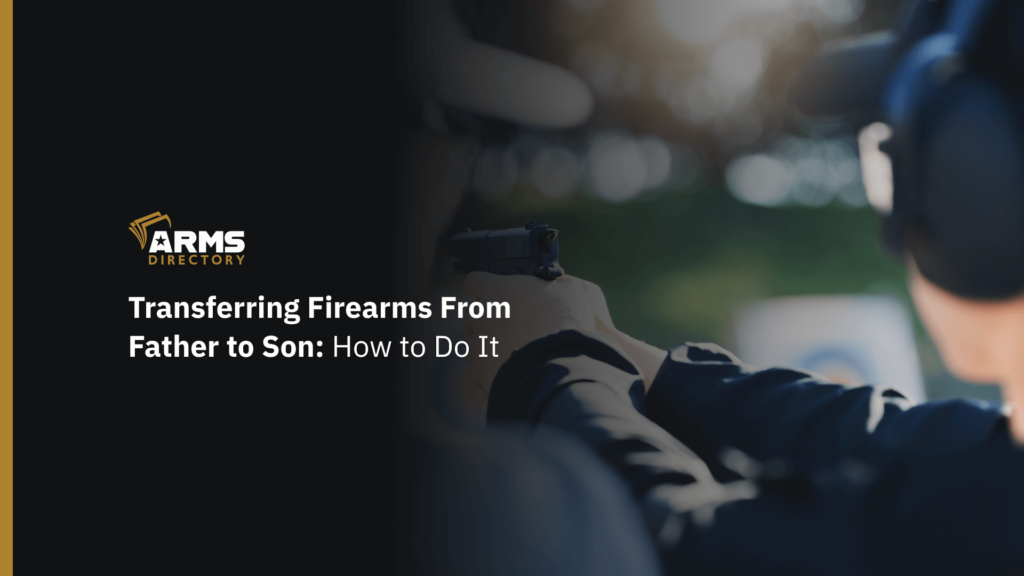
Transferring Firearms From Father to Son: How to Do It
Transferring firearms from father to son, particularly, and transferring ownership of a gun, is a process that requires careful attention. Although a private gun transfer might seem like a pretty straightforward process, you need to keep in mind some important things.
Let us review the procedure in detail.
Transferring Firearms from Father to Son
- Familiarize yourself with local gun laws
- Establish if the son can legally own a gun
- Find the classification of your weapon
- Report the transfer to the DOJ
1. Familiarize Yourself With Local Gun Laws
Every state has different requirements for gun registration. In all cases, it is mandatory to first familiarize yourself with the federal and national gun laws before you attempt to transfer the firearm.
For instance, in Canada, you must register your firearms, while in the U.S., most types of firearms have no federal requirement for registration (except for rifles, short-barreled shotguns, machine guns, and suppressors).
However, you should still check the local laws, since, for example, in New York, only the registration of handguns is required, while Hawaii requires the registration of all firearms.
On top of that, a lot of states maintain records of all firearm sales or transfers, even if they do not require firearm registration.
Additionally, do not forget to check local regulations for the type of gun you are looking to transfer. You see, different laws apply to different types of firearms.
Let’s say you live in New York State and you want to transfer a firearm that is now classified as an assault weapon. You can only transfer it to someone who resides outside of New York State or to a Federal Firearms Licensed Dealer.
Remember that it’s better to ask than to assume. You can always contact your local police department, if you are not sure how certain laws apply in your situation.
2. Establish if the Individual Can Legally Own a Gun
Before you transfer the firearm, it is your responsibility to check if the person is eligible to receive it. There are certain individuals who are ineligible to own a gun. Again, laws may vary a lot from state to state, yet there are some general things you need to look into:
- Is the person above the legal age to own a firearm?
- Do they need a license or permit to own a gun in your area?
- Does the person have a criminal history that would stop them from legally owning a gun?
- Has the person been committed to a mental institution or found to be mentally defective?
- Are they a legal U.S. citizen?
When it comes to inheriting guns from relatives (parents, grandparents), once more, it depends on the local laws. For instance, in California, the rules on how to transfer a gun to a family member are the following:
- All interested parties must live in California, and are all above 18 years of age (21 for handguns).
- No more than 5 family firearms transfers can be done per year.
- The person receiving the firearm must have general firearm safety certificates.
- A firearm is restricted to a single registered owner who must pass a background check.
Related Post: The Right Way to Buy and Sell Firearms Online [Guide] – Arms Directory
3. Find the Classification of Your Weapon
According to the federal and state law definitions, an assault weapon mainly refers to semi-automatic rifles, pistols, and shotguns that are able to accept detachable magazines and possess one or more other features. If your firearm is classified as such, transferring it in most states will be impossible.
Do take the time to check your local gun laws regarding assault weapons, as they may differ. Most states, like Virginia, Idaho, Nevada, Ohio, Minnesota, and so forth regulate assault weapons, but do not ban them, while states like California, Washington, Illinois, and Maryland have an assault weapons ban.

4. Report the Transfer to the DOJ
The transfer of firearms between a parent and their child, or a grandparent and their grandchild, is exempt from the requirements of the law, which orders the transaction to be made through a licensed dealer.
Still, the transfer must be reported to the Department of Justice (DOJ) using a Report of Operation of Law or Intra-Familial Firearm Transaction (form BOF 4544A). You must submit the form within 30 days of the transaction.
When you want to transfer or sell firearms that are not within the family, you need to follow this process (California example):
- Obtain a valid Federal Firearms License (FFL).
- Get all regulatory (business) licenses required by the local municipality.
- Have a valid seller’s permit from the State Board of Equalization.
- Obtain a certificate of eligibility from the Department of Justice.
- Have an appropriate 1-year license from an authorized licensing agency.
- Wait a 10-day passing period before the firearm is released to the buyer/transferee.
What About Antique Firearms?
It is possible that you inherit guns that were manufactured before 1899. These are considered to be antique, and this leads to a different scenario.

Of course, the laws in your state may vary when it comes to antique firearms – if you are not sure about something, it is always best to consult an expert for accurate and up-to-date information specific to your situation.
The process of transferring antique firearms in the United States may vary depending on specific regulations and requirements set by federal, state, and local authorities. Yet, there are still some general guidelines you should keep in mind:
- Research Applicable Laws. Familiarize yourself with federal, state, and local laws regarding the transfer of antique firearms. These laws may determine the eligibility criteria, paperwork, and restrictions associated with the transfer.
- Determine Antique Status. Confirm whether the firearm meets the definition of an antique under relevant laws. In the United States, antique firearms are typically those manufactured before 1899 or are replicas of such firearms.
- Complete Required Forms. Depending on the specific circumstances and jurisdiction, there may be paperwork involved in transferring an antique firearm. This might include papers like a bill of sale, a record of a transfer, or other things that federal, state, or local authorities need.
- Verify Age and Authenticity. Provide documentation or evidence to show that the gun is old and genuine, as required by the transfer process. This may include historical records, expert assessments, or manufacturer markings.
- Background Checks. While, as we mentioned, antique firearms are generally exempt from background checks under federal law, certain states may have additional requirements. It is important to double-check with the relevant authorities to understand specific regulations in the area of transfer.
- Other Considerations. It is necessary to comply with any other additional requirements set by local authorities. These may include transportation regulations, storage requirements, restrictions on specific types of antique firearms, etc.
Related Post: The History of Guns: Importance and Timeline – Arms Directory
Summary
How to transfer ownership of a gun depends on local regulations. Transferring firearms from father to son or between other family members might not be such a complicated process, but in all cases, it requires you to research the local laws, as they can be different for every state.
Remember that you should always consult an expert, especially if you are not certain about how to proceed. They can provide you with accurate, and up-to-date information about your specific situation.
Are you interested in claiming your business profile and growing with us? Feel free to join the #1 firearms platform.

![Gun Registration Requirements by State [What You Need to Know]](https://vault.armsdirectory.com/wp-content/uploads/2023/10/27073220/Gun-Registration-Requirements-by-State-What-You-Need-to-Know-1024x576.png)
![The Right Way to Buy and Sell Firearms Online [Guide]](https://vault.armsdirectory.com/wp-content/uploads/2023/10/20050323/The-Right-Way-to-Buy-and-Sell-Firearms-Online-Guide-1-1024x576.png)

![The Ultimate Shooting Accessories for Every Weapon [A 2023 Beginners Guide]](https://vault.armsdirectory.com/wp-content/uploads/2023/08/30071223/The-Ultimate-Shooting-Accessories-for-Every-Weapon-A-2023-Beginners-Guide-1024x576.png)
